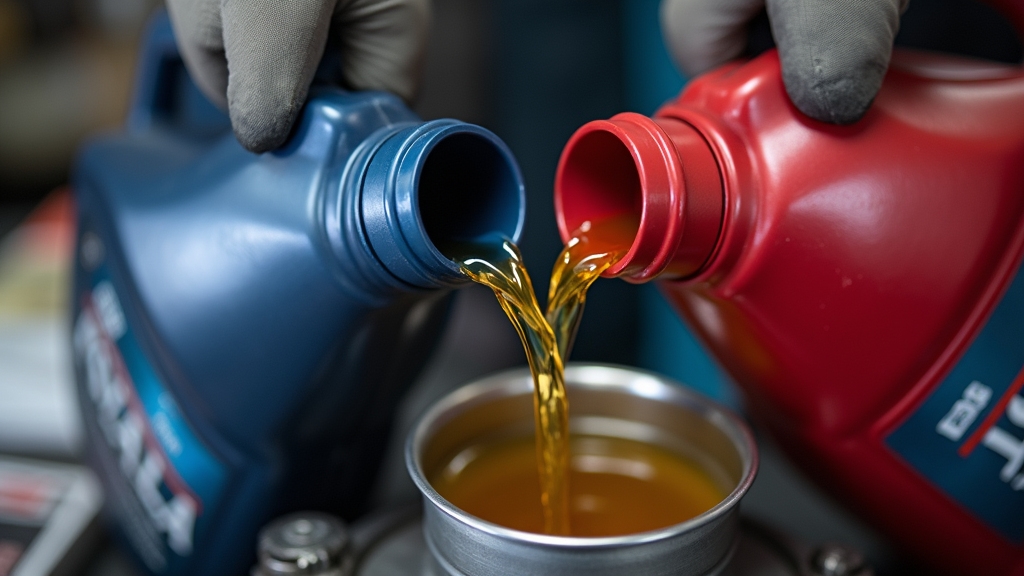Physical Address
304 North Cardinal St.
Dorchester Center, MA 02124
Physical Address
304 North Cardinal St.
Dorchester Center, MA 02124

You can mix 0W20 and 5W30 oils temporarily without causing immediate chemical reactions since their synthetic bases are compatible.
However, blending changes viscosity and disrupts additive balance, which may reduce engine protection and affect oil performance under different temperatures.
This can impact startup lubrication, wear resistance, and possibly void warranties if done long-term. It’s best to stick to the recommended grade and replace mixed oil promptly.
There’s more to evaluate about these effects and best practices.
Although 0W-20 and 5W-30 oils differ in viscosity, their similar base oil compositions and additive packages generally allow them to blend without causing immediate chemical incompatibility. Both oils, especially when synthetic, exhibit oxidation resistance which helps maintain performance over time.
0W-20 and 5W-30 oils have compatible bases, allowing safe blending without immediate chemical issues.
When you combine these oils, the resulting viscosity typically falls between the two grades rather than replicating either precisely. Synthetic formulations, common in both grades, use standardized base stocks that enhance compatibility.
However, repeated mixing can disrupt the additive balance, potentially diminishing detergent, anti-wear, and dispersant efficacy over time.
While no significant chemical reactions occur that could instantly harm your engine, the altered additive synergy might degrade oil performance if mixing becomes habitual.
In short, occasional blending is chemically safe, but you should avoid it as a long-term practice to maintain optimal oil functionality and engine protection.
It is generally safe to mix these oils for top-up emergencies, but it should not be a regular practice.
Understanding how viscosity differences influence engine performance helps clarify the practical effects of mixing 0W20 and 5W30 oils.
You’ll see that 0W20 flows faster during cold starts, offering superior initial lubrication.
In contrast, 5W30 provides thicker, more protective films at high temperatures.
When mixed, the resulting intermediate viscosity creates unpredictable cold flow and lubrication dynamics.
This could compromise startup protection or high-temperature wear resistance.
This blend alters oil flow rates through galleries, possibly causing inconsistent oil pressure and lubrication zones outside original engine specifications.
Additionally, the mid-range viscosity may slightly reduce 0W20’s fuel efficiency advantage while improving wear protection under stress.
Consequently, mixing these oils impacts hydrodynamic lubrication balance, friction losses, and metal-to-metal contact.
This affects overall engine performance in nuanced, temperature-dependent ways.
Moreover, the presence of anti-wear additives in motor oils is critical to protect engine components under varying conditions.
It is important to consult the vehicle’s owner’s manual since the recommended oil viscosity ensures optimal engine protection and performance.
When you mix 0W-20 and 5W-30 oils, you risk creating a viscosity that falls outside your vehicle manufacturer’s exact specifications. These specifications are designed to maximize engine performance and protection. It is important to consider the engine protection technologies of the oils being mixed to ensure compatibility.
Manufacturers typically require strict adherence to recommended oil grades to guarantee warranty validity and engine longevity.
Consider these points:
Since engine oils rely on carefully formulated additive packages to deliver critical functions like anti-wear protection, detergency, and corrosion inhibition, combining oils with different additives can disrupt their chemical balance and impair performance. Many oil additives contain advanced nanoparticles or revitalizers designed to reduce engine wear and improve longevity.
Engine oils depend on precise additive blends; mixing different oils can upset this balance and reduce effectiveness.
When you mix 0W-20 and 5W-30, the competing additives may lose synergistic effects, reducing their effectiveness in protecting engine surfaces and controlling deposits.
This incompatibility can dilute anti-wear and oxidation inhibitors, accelerating component wear and oil degradation.
Additionally, altered additive interactions may compromise oil film strength and flow, impacting sensitive systems like variable valve timing. It is important to maintain the same viscosity and oil classification to minimize potential additive conflicts and maintain engine protection consistency in viscosity.
Over time, inconsistent additive chemistry increases the risk of sludge buildup, bearing wear, and corrosion.
Therefore, mixing oils with differing additive packages can undermine the protective roles of engine oil, potentially leading to premature engine damage and reduced durability.

Although mixing 0W-20 and 5W-30 oils isn’t ideal, you can safely do so in emergencies or for short-term top-ups without immediate engine damage.
To minimize risk and maintain engine health, follow these best practices:
Yes, mixing 0W20 with 5W30 can slightly affect your fuel economy.
Because 5W30 is thicker at operating temperatures, it increases engine friction compared to 0W20. This potentially reduces miles per gallon, especially during cold starts.
However, the impact is usually minimal unless you use a high ratio of 5W30.
For ideal efficiency, stick close to your manufacturer’s recommended viscosity grade.
Yes, it’s safe to mix synthetic and conventional oils of 0W-20 and 5W-30 viscosities; studies show compatibility rates exceed 95%.
However, mixing dilutes synthetic oil’s superior additives, potentially reducing long-term engine protection.
You should only mix in emergencies or for topping off small amounts.
For ideal engine performance and longevity, stick to the manufacturer’s recommended oil type and viscosity.
Avoid regular mixing as a maintenance practice.
Temperature influences mixing 0W-20 with 5W-30 by creating an intermediate viscosity that balances cold start flow and high-temperature protection.
You’ll notice easier oil circulation during cold starts due to 0W-20’s lower winter viscosity, while 5W-30 ensures a thicker lubricating film as the engine heats up.
This blend adapts viscosity across temperature ranges, but always verify compatibility with your engine’s specifications to avoid compromising lubrication efficiency or engine wear.
Mixing these oils won’t cause noticeable engine noise or vibration, much like a whisper lost in a noisy room.
You might experience subtle changes in oil thickness, which could slightly affect oil pressure or flow, but under normal conditions, your engine won’t detect it.
However, prolonged use of mixed grades might impact lubrication quality, potentially leading to mechanical noise over time, especially in high-precision or variable valve timing systems.
Stick to manufacturer specs for best results.
Yes, mixing oils like 0W20 and 5W30 can slightly influence oil change intervals and sensor readings.
You mightn’t need earlier changes if both oils meet specifications, but minor fluctuations in viscosity can affect oil consumption and sensor accuracy.
Modern engines handle these variations well, yet you should observe oil condition closely.
Consider more frequent checks to guarantee additive balance remains effective and sensors provide accurate feedback on oil quality.
Mixing 0W20 and 5W30 oils is like blending two paints with slightly different textures. While possible, the result may not be perfectly uniform.
You need to evaluate viscosity impacts, additive compatibility, and manufacturer guidelines carefully. Ignoring these factors can affect engine performance and potentially void warranties.
To maintain ideal protection, it’s best to stick to one oil type or change oils at appropriate intervals rather than mixing them frequently.